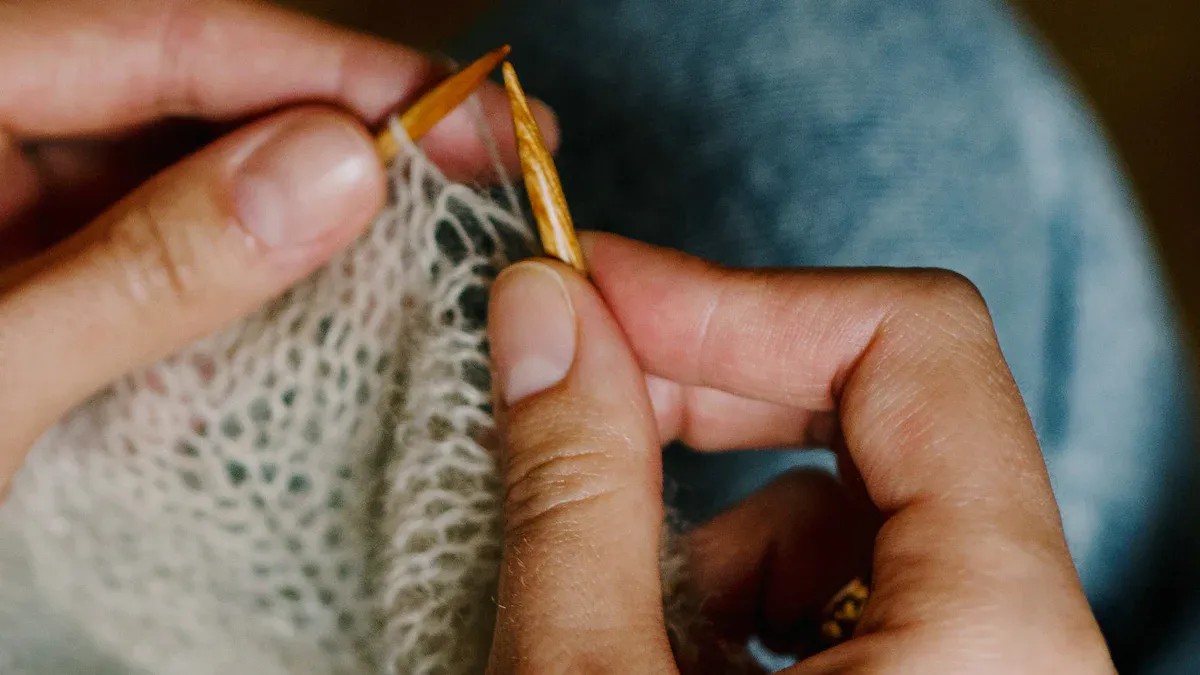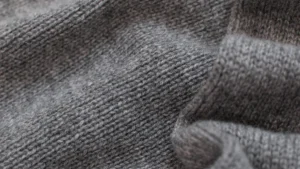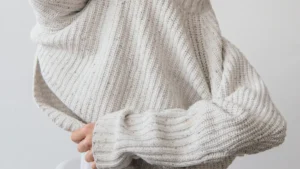
You might wonder what is yarn over in knitting. This simple move lets you create extra stitches or small holes for patterns. Many people use yarn over in knitting for lace or buttonholes. Here is an easy explanation: you wrap the yarn over your needle. Yarnover helps add beauty and shape to your work.
Key Takeaways
A yarn over is an easy knitting step. It adds a new stitch and makes a small hole. This hole looks nice and works well for lace or buttonholes.
You can use yarn overs to change the shape of your project. They help you add pretty patterns and make buttonholes. Yarn overs let you be more creative and flexible in knitting.
Try different yarn over ways and keep your tension the same. This helps you make neat holes that look alike. It also helps you get better at knitting.
What Is Yarn Over in Knitting

Yarn Over Definition
When you want to know what is yarn over in knitting, you need a clear explanation. A yarn over is a simple move that lets you create a new stitch or a decorative hole in your fabric. You do not knit or purl a stitch at that moment. Instead, you just bring the yarn over or around your needle. This extra loop becomes a new stitch when you work the next row.
Tip: Yarn over in knitting stands out from other increases. You do not work into a stitch. You only move the yarn, which makes a visible hole or eyelet in your project. This is different from other methods that use the same stitch to make more stitches right away.
You can create a yarnover in several ways, depending on the stitches before and after. This makes the technique very flexible. If you want a systematic and logical explanation, remember: a yarnover always adds one stitch and often leaves a small hole, which is perfect for decorative effects.
Purpose of Yarn Over
You use a yarnover for many reasons. The main purpose is to increase the number of stitches on your needle. This is important when you want to shape your project or add design features. A yarnover also creates a hole in the fabric. Many patterns use these holes for decoration or for practical reasons.
You can use a yarnover to make lace patterns. The holes form beautiful shapes and add texture.
Yarn over in knitting helps you make eyelets, which are small, neat holes.
You can use a yarnover to make buttonholes, especially in baby clothes or toys.
Sometimes, you pair a yarnover with a decrease to keep the stitch count the same but add a decorative effect.
If you need a bigger hole, you can use a double yarnover.
A yarnover is easy to learn and gives you many creative options. When you look at what is yarn over in knitting, you see that it is both useful and beautiful.
Common Uses
You will find yarnover in many popular patterns. Designers use it for both function and style. Here are some common uses:
Lace knitting: Yarn over is the main way to make the open spaces in lace. You see this in shawls, scarves, and sweaters.
Eyelets: These small holes add detail to plain fabric. You can use them in rows or scattered for a fun effect.
Buttonholes: The eyelet buttonhole is a classic. You make it by working a yarnover and then knitting two stitches together. This makes a small hole for a button. If you need a larger hole, use a double yarnover.
Decorative motifs: Yarn over can create patterns like raindrops or flowers.
Novelty stitches: Some patterns use yarnover to make long, dropped stitches or special textures.
Yarn over in knitting appears in many projects. You see it in lace, in button bands, and in decorative panels. Many patterns use yarnover to add both structure and beauty. When you master this skill, you can follow a wide range of patterns and create unique designs.
Note: Yarn over is a foundational skill for beginners. You will use it often, so practice until you feel comfortable.
If you want a full explanation of what is yarn over in knitting, remember that it is a simple move with many uses. It helps you increase stitches, make holes, and add style to your work. With this knowledge, you can read patterns with confidence and enjoy trying new techniques.
How to Do a Yarn Over

Learning how to do a yarn over is a key skill in knitting. You will use this move in many patterns, from lace to buttonholes. Each situation—between knit stitches, between purl stitches, or when switching between knit and purl—has its own method. Follow these instructions to master each version.
Between Knit Stitches
When you want to make a yarn over between two knits, follow these steps:
Start with the working yarn at the back of your work, just as you do when knitting.
Bring the yarn forward between the two needles to the front of your work.
Move the yarn over the top of the right needle.
Knit the next stitch as usual.
On the following row, knit the strand created by the yarn over as a normal stitch. This creates an extra stitch and a decorative hole.
You will notice a small, neat hole in your fabric. This is the main visual cue that you have done the yarn over correctly. The hole adds a lace-like effect and makes your project look more interesting. If you want to see this process in action, many video tutorials show how to do a yarn over between two knits.
Between Purl Stitches
A yarn over between two purls needs a slightly different approach. You will use a backwards or reversed yarn over before the purl stitch. Bring the yarn to the front over the top of the right needle before you purl. This method helps keep the hole smaller and more even. On the next row, knit into the back leg of the yarn over to keep the stitch open and untwisted.
Common mistakes with a yarn over between two purls include wrapping the yarn incorrectly or pulling too tightly. This can make the hole too large or uneven. To avoid this, always check your yarn placement and keep your tension relaxed. If you want to practice, try making a swatch and compare the results. Watching video tutorials can also help you see the correct motion for a yarn over between two purls.
Between Knit and Purl
You will often need to make a yarn over between a knit and purl stitch. The method changes based on the direction:
For a yarn over between a knit and purl, bring the yarn forward into the purl position, then carry it over the right needle and between the needles to the front. You are now ready to purl the next stitch.
For a yarn over between a purl and knit, keep the yarn in front after the purl, then knit the next stitch. The yarn will naturally pass over the needle, creating the yarn over.
Each different version of the yarnover depends on the stitches before and after. Pay attention to the yarn’s path to make sure you create the correct hole and stitch.
Tips for Consistency
Keeping your yarn overs even and neat takes practice. Here are some tips to help you:
Wrap the yarn around your fingers the same way each time to keep tension steady.
Practice how to do a yarn over on scrap yarn until you feel comfortable.
Try different yarns. Some, like wool, make it easier to keep even tension than others, like acrylic.
Adjust how you hold the yarn and needles. Find a grip that feels natural and helps you control the yarn.
Relax your hands and shoulders before you start. Stress can make your stitches too tight or too loose.
Keep your stitches close to the needle tips and adjust them every few stitches.
Do not pull the yarn too tight after making a yarn over. The stitch should slide easily on the needle.
Tension affects the size of the holes in your finished work. Tighter tension makes smaller holes, while loose tension makes larger ones. If you want your yarn overs to look the same throughout your project, focus on keeping your tension even. Blocking your finished piece can also help even out the holes.
Troubleshooting Mistakes
Even experienced knitters make mistakes with yarn overs. Here are some common problems and how to fix them:
If you miss a yarn over, you can fix it on the next row. Insert your needle under the strand between stitches where the yarn over should be, then knit it as usual.
If you find a mistake two rows back, insert your needle under the second strand between stitches and pull it through to create the missing stitch.
If you wrap the yarn incorrectly, you might see extra loops or a hole that is too big. Check your yarn placement and make sure you only wrap the yarn once.
If your yarn over holes look uneven, check your tension. Try to keep the yarn relaxed but not loose.
Use stitch markers to help keep track of where you need to make a yarn over, especially in lace patterns.
If you need to fix a yarn over at the beginning of a row, use the same method: pick up the strand between stitches and knit it. You can also use a darning needle and matching yarn to mimic a missing yarn over after finishing your project.
Tip: Double yarn overs create larger holes. To make one, wrap the yarn over the needle twice instead of once. On the next row, work each loop as the pattern instructs. This is useful for big eyelets or special effects.
Learning how to do a yarn over at the beginning of a row or in the middle will help you follow many patterns. With practice, you will master each different version of the yarnover and avoid common mistakes.
Why Yarn Over Matters
Increases and Shaping
You use yarn over to add new stitches to your knitting. This technique helps you increase the stitch count and shape your fabric. When you place yarn overs in certain spots, you can create flat shapes like medallions or shawls. For example, you might see yarn overs spaced evenly in square or hexagonal designs. Sometimes, you use double yarn overs for extra ease. In lace knitting, you often pair yarn overs with decreases. This keeps your stitch count steady while you shape the fabric. Planning where to put yarn overs and decreases lets you keep your lace pattern looking neat as you shape your project.
Decorative Effects
Yarn overs do more than just increase stitches. They also create beautiful holes or eyelets in your fabric. These holes are the main feature in many lace designs. When you combine yarn overs with decreases like knit two together, you form the open, airy look of lace. You can make simple mesh or complex shapes like leaves and flowers. Many lace knitting patterns use yarn overs to build these delicate effects.
Tip: Yarn overs let you add both texture and lightness to your projects. You can use them to make scarves, shawls, or even sweaters look more interesting.
Pattern Versatility
Yarn overs make your knitting more flexible. You can use them to create decorative holes for lace, shape garments, or make buttonholes. Multiple yarn overs give you bigger holes or longer stitches. You can work yarn overs on both knit and purl sides, which means you can use them in many types of patterns. Some knitters use yarn overs in Brioche knitting, short rows, or stretchy bind-offs. You can even control the size of the hole by twisting the yarn over or leaving it open. This makes yarn overs a key tool for both function and style in your knitting.
When you learn yarn overs, you get more control and ideas in knitting. You can change the shape of your fabric and add eyelets. You can also try harder patterns.
Try many kinds of yarn overs to get better and feel more sure of yourself.
Remember: Every time you try, even if you mess up, you learn more about knitting. Have fun and let your creative side show!
FAQ
What should you do if you forget a yarn over?
You can pick up the strand between stitches on the next row. Knit it as a new stitch. This quick fix helps keep your pattern correct.
Can you use yarn over with any type of yarn?
Yes! You can use yarn over with any yarn. Thicker yarns make bigger holes. Thinner yarns create smaller, delicate eyelets.
Why does your yarn over sometimes look twisted?
A twisted yarn over happens when you knit into the back loop by mistake. Always knit into the front of the yarn over to keep the hole open.









